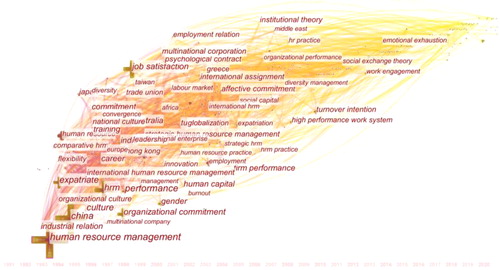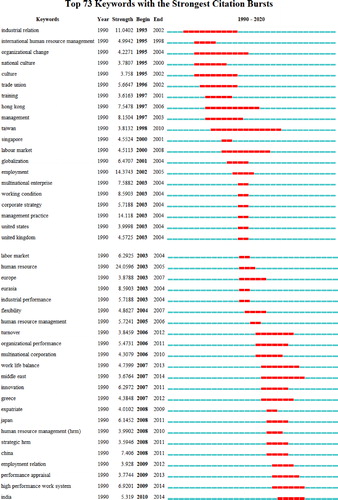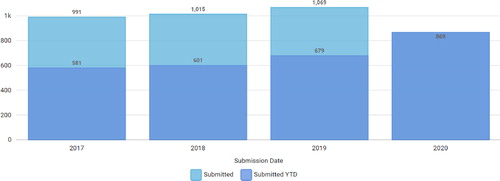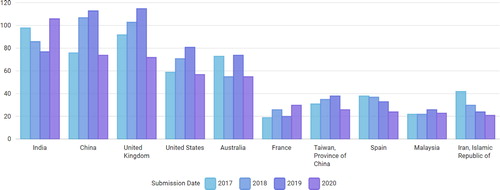Abstract
In this paper, we take stock of what The International Journal of Human Resource Management (IJHRM) has achieved in the past 30 years since its inception in 1990. By analyzing the publication trends indicated by keywords, we find that research published in IJHRM has shifted from a collective focus with institutional implications towards more individual concerns with organizational implications with relevance to HRM practices. We present research theme and approaches that distinguish IJHRM from other HRM journals, and offer suggestions of what we see as some of the important issues for future research that will take us beyond the current trajectory of HRM studies.
Introduction
The year 2020 has no doubt been an extremely challenging year for most of us due to the global pandemic of COVID-19 and the resulting economic downturn. Many businesses have suffered huge losses beyond their breaking point, and millions of workers have lost their jobs with reduced prospects of re-engaging in gainful employment in the near future. For those who remain in business and in employment, fundamental changes have occurred or are occurring in the ways businesses operate and work is carried out. These changes have serious implications for human resource management (HRM) in practice and as a field of research. In this paper, we take stock of what The International Journal of Human Resource Management (IJHRM) has achieved in the past 30 years since its inception in 1990. While major shocks have happened on a global (e.g. financial crisis 2007–8) and country (e.g. Zimbabwe hyperinflation, Argentina debt crisis etc.) scale we believe that COVID-19 has the potential to substantially change national and international HR approaches and the world of work in general. Looking back at the history of IJHRM we assess our status quo. We find that HRM research published in IJHRM has shifted from a collective focus with institutional implications towards more individual concerns with organizational implications. Below, we will nuance this general observation. In addition, we offer suggestions of what we see as some of the important issues for future research that will take us beyond the current trajectory of HRM studies.
Looking back: what has been published in IJHRM
As shown in , since its launch in 1990 by the late Founding Editor Professor Michael Poole, IJHRM has expanded considerably in the number of articles it publishes in a year (from only three issues in 1990 to 22 issues in 2020), and in the scope of HRM themes that it covers, including areas such as functional and strategic HRM, organizational behaviour with HRM implications, employment relations and global work.Footnote1 Over time, the journal has expanded its interests which include but are not restricted to: future trends in HRM and the world of work; strategic HRM; international HRM; employment relations; employment law; HRM and technology; including the impact of artificial intelligence; diversity and inclusion; talent management and leadership; global careers; rewards and performance management; organizational change and its implications for HRM; organizational culture; responsible and sustainable HRM; people analytics; and new ways of working.
Figure 1. Number of papers (including articles and reviews) published in IJHRM (January 1990–December 2020).
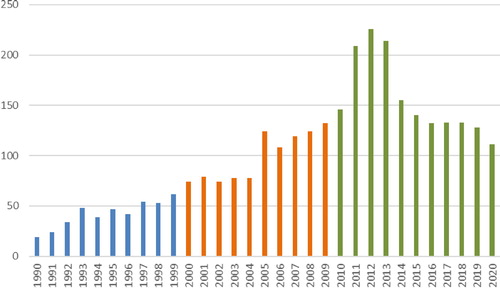
Most researched topics of HRM in IJHRM
An analysis of the key words in the database reveals that a large proportion of the papers focus on HRM, this is not surprising given the title of the journal. Unsurprisingly, multinational companies have attracted considerable research attention with a significant focus on expatriation and repatriation. Performance and organizational behaviour (OB, e.g. job satisfaction, organizational commitment, and turnover) are also amongst the most researched topics. In addition, diversity and equality issues have attracted a lot of research attention (see ). It is worth noting that this summary may not reflect precisely what has been really studied in the articles as we are dependent on authors to provide the keywords which they believe best capture their articles. Since a maximum of six keywords are permitted, there may be a level of subjectiveness in what authors decide to include and exclude as keywords. For example, compared to HRM functions or areas of research, theories adopted by the studies are rarely reflected in the key words, judging by what the keywords have recorded (see ). Nonetheless, we are confident that provides an informative summary of key thematic areas of research in IJHRM in the last 30 years.
Table 1. A summary of most research topics in IJHRM as indicated by article keywords.
Research hotspots analysis – keyword clustering
Keywords in academic literature summarize the research topics of the article, and the analysis of keyword clustering can help determine the hotspots and frontiers of a certain research field. In order to shed light on what the research hotspots and frontiers are in IJHRM, we used CiteSpace to identify keyword co-cited references clustering. Using CiteSpace, with years per slice set to one year, keyword as the node type, the selection threshold set to the top 50, and log-likelihood ratio (LLR) as the algorithm, a total of eleven clusters were automatically generated and sorted according to their scales/sizes (see and ). Each cluster corresponds to an underlying theme, a topic, or a line of research. shows a map of the eleven clusters of keyword co-occurrence in articles published in IJHRM.
Figure 2. Map of eleven keyword clusters generated by CiteSpace.
Note: ‘adr’ in Cluster 11 = alternative dispute resolution
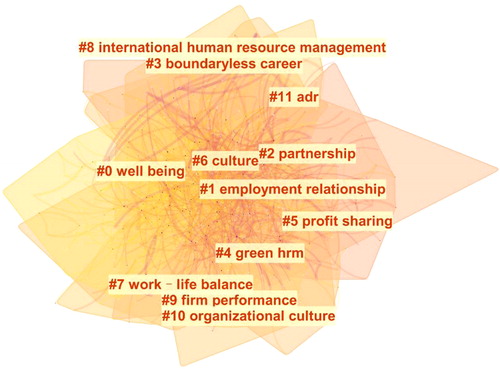
Table 2. A summary of eleven clusters of research hotspots.
As shows, Cluster #0, which is labelled ‘well-being’, ranked first as the largest cluster, and contains 91 co-cited references with a mean Silhouette value of 0.787. This is followed by Cluster #1, which is labelled ‘employment relationship’, and contains 70 co-cited references with a mean Silhouette value of 0.783 (a mean Silhouette value close to 1 indicates that references within a cluster contain highly consistent or similar content). It is interesting to see that the mean years of these 11 clusters mainly appear to be in the mid-2000s, with well-being centred around the early 2010s. These 11 clusters confirm the major fields of research interest covered by IJHRM (i.e. HRM, international HRM, employment relations and dispute resolutions), as well as key topical areas of a particular period related to these fields (e.g. employee well-being, work-life balance, partnership, green HRM, and firm performance). Moreover, despite the fact that OB topics have featured quite heavily in the keywords shown in as listed by authors, they have not yet formed strong networks of co-citations. This may be due to the fact of the disparate interests in the OB topics, some of which were only gaining (rapid) traction in recent years in IJHRM. However, these are emerging in the research frontiers which we will now turn to.
Research frontier analysis – timezone and burst term
CitesSpace’s time zone evolution map can illustrate the research trend of a certain field in different periods. This analysis takes a time slice of one year to improve the time zone discrimination of the knowledge map. The map has a total of 751 nodes and 1,929 links. As indicates, organizational commitment (consisting of affective commitment, continuance commitment and normative commitment) appeared in the late 1990s to the mid-2000s, while affective commitment became the research frontier topic during the mid-/late 2000s as research on organizational commitment became more sophisticated and focused on the type of commitment that is believed to be the most effective in enhancing organizational performance (Meyer & Allen, Citation1991). In the early to mid-2010s, turnover intention and high-performance work systems became the research frontier topics; whereas work engagement and emotional exhaustion emerged as the research frontier since the mid-2010s. Social exchange theory appears to be a main theoretical framework underpinning research in the past decade. This pattern indicates that HRM research published in IJHRM has become more individual and OB focused, a general trend of HRM and, to a lesser extent, employment relations research that has been observed by Kaufman (Citation2015) and others (e.g. Budd, Citation2020). By contrast, research on topics related to industrial/employment relations, labour market, labour regulation and collectivism have become limited, albeit they remain important in workplace relationship management and, arguably, will be even more critical with social policy, business and workforce concerns as nation states struggle to revitalise their economy post-COVID-19, which is likely to lead to the further growth in the gig economy and casual employment (c.f. International Labour Organization, Citation2020).
The term bursts refer to keywords that appear frequently in the co-citation networks in a specific time. By analyzing the burst terms, we can understand the research foci in a particular field in a given period and project the research trend. By setting the minimum duration unit of the burst term as 1 on Citespace, we identified top 73 keywords with the strongest citation bursts (see ). indicates the trends of research foci based on the burst time and duration span. It confirms our observation above in relation to how HRM research has shifted from collective concerns with institutional implications, such as labour regulation and workers organization, towards individual concerns with organizational implications, such as developing HRM practices that will yield certain desirable behaviours from the employees. Of course, the general trend may mask some specific topics that have resulted in institutional developments such as the strong research interest in diversity and inclusion that explores company approaches but can inform wider institutional changes.
Figure 4. Top 73 keywords with the strongest citation burst.
Note: IJHRM does not specify particular type of English spelling to be used as long as it is consistent within the article, hence the same phrase may be spelt in two ways and listed separately in (e.g. labour market; labor market).
Submissions
We are lucky to still have one member of the original team who launched IJHRM in 1990 on board. Mrs Penny Smith manages much of the administration associated with a journal that has well over 1,000 submissions per year, as shown in , and is unfailingly committed to improving the quality of the journal. IJHRM is a journal that is not only a constant window of new ideas and new avenues of research but is also the premium outlet for research based on less well-covered countries, particularly developing countries. This long-established support for research from a diversity of countries has seen the considerable growth of submissions from developing countries in recent years (see ). IJHRM values diversity also in relation to research methods and is inclusive of qualitative, quantitative and conceptual approaches, as well as of a myriad of theoretical frameworks and lenses. With the growth in the number of submissions – and the objective to optimize the quality of the papers published in the journal - comes a reduced percentage of acceptance rate (see ). Despite the increasing pressure of finding willing reviewers, IJHRM strives to take a developmental approach in working with authors and therefore has made a commitment to send around 40 percent of the papers out for review in order to help authors improve their manuscripts and work towards publication.
What distinguishes IJHRM and looking ahead
Journals are unique in their foci, style, and disciplinary perspectives. We consider here what we envisage to be ahead of us and how the research themes that have previously formed a strong basis for IJHRM’s contribution to the HRM field might develop moving forward.
The future of work post-COVID-19
Looking at the future is inherently fraught with difficulties, especially in these uncertain times. The high potential of COVID-19 to disrupt and change the world of work is showing strong impact already and is likely to have a lasting effect. Already we are seeing academic and professional articles and reports emerging that aim to predict some key developments for the post-COVID period (e.g. in Expatriation and Global Mobility, see Dickmann & Bader, Citation2020). Above, we have charted some of the trends and important areas that have shaped IJHRM’s contribution to the global academic HR discourse. While this is a starting point, it cannot suffice when we depict our expectations of academic HR research activity and the path and areas that might be covered by the journal in the short-medium term future. Below you will find some areas that we believe will matter to us in IJHRM and to the HR community in the future. The list is not exhaustive but intended as a start.
Key topics include, first, the appeal that HRM research maintains a strong connection to the external context it is embedded in, most prominently the interaction with societal and institutional factors which are likely to be affected by external and internal crises (such as COVID-19). Second, we continue to see strong interest in international working, including multinational configurations, diverse forms of global mobility (including company assigned, self-initiated, business travelling, virtual forms of working across borders), career experiences and other implications of working with multinational teams or in locations other than one’s home country. While COVID-19 has certainly left a mark on current global working patterns, many issues in global mobility remain underexplored. Third, in the future, we believe that the developments of technology, including artificial intelligence, e-HRM and remote forms of working will be even more relevant than they are today. Therefore, we are interested in technology and HRM and the changes technological and managerial innovation will bring to the world of work and working. Fourth, COVID-19 and other developments continue to shine a spotlight on issues such as employee engagement, voice, diversity and inclusion and more traditional field of HR practices. In addition, we perceive a need to undertake more employee well-being oriented HRM research in times of uncertainty and crises. Lastly, global challenges beyond the current pandemic will not disappear and we note a strong interest in sustainable HRM, including issues of ‘green HRM’ and ethical approaches to designing and managing the world of work. At IJHRM we actively encourage authors to undertake multi-level research capturing macro, meso and micro levels which can serve to explore some of the issues above.
Maintaining a strong connection of HRM research and the external environment
IJHRM has always been keen to publish research that focuses on HRM, industrial/employment relations and labour market issues that are important to society, policy makers and organizational management. Moving forward, IJHRM will continue to encourage high quality research on a wide range of HRM-related issues that affect not only individuals and the organizations in which they work, but also societies, communities and families.
A distinct feature of IJHRM is its concern about politico-socio-economic issues, often embedded in historical contexts, which affect the broader society. Here, Peter Ackers’ (Citation2014) paper ‘Rethinking of the employment relationship: a neo-pluralist critique of British industrial relations orthodoxy’ offers an excellent critique of the existing approach to British industrial relations and calls for an approach that emphasises social cohesion and the importance of social values over interests, cooperation over conflict, and trust over power. In their introductory paper for the special issue on the role of the state in HRM, Martinez Lucio and Stuart (Citation2011) pointed out, ‘the wider role of the state in HRM remains under-examined and under-theorized’ (p. 3662), despite the need for HRM ‘to be contextualized against wider sets of political and regulatory forces (p. 3667). In elucidating the persisting albeit changing roles of the state, Martinez Lucio and Stuart (Citation2011, p. 3665) argue that models of management and employment practices ‘are in part politically constructed, strategically disseminated and ideologically supported’. Moreover, there are ‘new sets of state activities aimed at remaking the ideological and practical bases of employment and its management’ (Martinez Lucio & Stuart, Citation2011; p. 3665). Although statism is often associated with developing countries and seen as an unwelcome/undesirable political behaviour in a neo-liberalist setting, state intervention has never been removed in business, with implications for how firms develop capabilities and resources to gain competitive advantages (e.g. Martinez Lucio & Stuart, Citation2011; Wood & Wright, Citation2015). Similarly, Moon and Prasad (Citation1994, p. 360) argue that a ‘crucial task of research lies in explaining how politics, institutions and leadership choices interact to constitute lines of policy and to shape trajectories of economic development’.
These arguments are particularly relevant in the post-COVID-19 global economic restructuring. Combatting the COVID-19 pandemic has not only triggered large-scale unemployment and under-employment, but also impacted education, skills training and work-based learning (ILO, Citation2020). Existing evidence suggests that the recovery of the economy and other aspects of social life from COVID-19 requires strong state policy intervention and institutional coordination and collaboration. In fact, policy responses from many countries have been unprecedented. For example, OECD countries have introduced a range of bold new measures and/or expanded existing ones considerably to address the impact of COVID-19, as shows (OECD, Citation2020). All these measures affect individuals, families, specific social groups and businesses in relation to employment and HRM implications.
Figure 8. OECD countries introduced bold new measures or considerably expanded existing ones in response to COVID-19.
Source: OECD (Citation2020, p. 49).
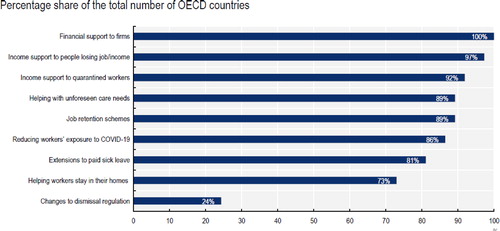
ILO also put forward a policy framework (see ) which illustrates the need for state direction and joint efforts of institutions in employment retention, employment safety net, and creating new employment and skills development opportunities.
Table 3. ILO policy framework: four key pillars in tackling the COVID‑19 crisis on the basis of international labour standards.
It is, therefore, fruitful to engage in HRM research that examines the role of the state, its agencies and other institutions to develop a fuller understanding of how these institutional forces at the national and sub-national level, often interacting with regional and global forces, shape management practices at the firm level. Such an approach has also been advocated by strategic HRM scholars (e.g. Boxall & Purcell, Citation2016; Jackson et al., Citation2014) and will be important to reassess in the post-COVID 19 world. We welcome research of this kind in IJHRM.
The role of technology and HRM
Technology has been a key focus in employment and labour process studies since the early 1970s (e.g. Ginzberg et al., Citation1987; Knight & Willmott, Citation1988). In contrast, the role of technology in HRM only started to gain traction in the late 2000s. Under the Editorship of Michael Poole, IJHRM was one of the first HRM journals that welcomed the topic of HRM and technology. The first special issue appeared in IJHRM in 2009 (Bondarouk & Ruël, Citation2009). Many more special issues and papers followed, with the focus of technology shifting from studying ‘simple’ ICT tools to digitalization, HR analytics, machine learning, gig workers, and more recently robotics in HRM (e.g. Bondarouk et al., Citation2017; Francis et al., Citation2014; Meijerink et al., Citation2018; Strohmeier, Citation2018). In the next year or so we will extend this theme through our special issues on the gig economy and HRM and artificial intelligence.
The impact of technology on our lives – and on the ways that we manage people – will undoubtedly continue to grow. Over the past few months as the result of COVID-19 we have seen an increased reliance on technology through the growth of remote working, online meetings and the use of robotics to undertake manual tasks such as cleaning and deliveries. This situation gives us an opportunity to examine reactions to technologies and its impact on work and employees, as well as the development of the sociomaterial context (Orlikowski & Scott, Citation2008) and the means by which HRM practitioners might manage this.
International HRM and research into global work during and post crisis
Our submission and citation data shows that there is a vibrant interest in international work and its many broad aspects. Many authors are interested in the strategies, structures, policies, practices and power relations within multinational firms. The emergence of COVID-19 has meant that many organizations have recalled some or all of their expatriate workers and have dramatically limited international business travel (Dickmann & Bader, Citation2020). The implications for multinationals and other internationally operating organizations in relation to their strategic goals associated with global mobility are likely to be substantial. Strategies that rely on human interaction and intangible processes – such as control & coordination and some knowledge transfer approaches (Edström & Galbraith, Citation1977; Harzing, Citation2001) – might be more restricted and may have to be adjusted. Indeed, global talent management/leadership approaches will also have to be reviewed.
It is clear that globally mobile workers are substantially affected by the current pandemic. Their careers, developmental opportunities, network building, adjustment, coping, performance and, crucially, well-being is currently highly impacted. With MNCs envisaging major changes to their global mobility approaches (strategies, policies, numbers) and individuals potentially re-evaluating the costs and benefits of working abroad there may be many changes that can be investigated in the future. These changes will affect not only traditional overseas workers (i.e. those who are sponsored by their organizations) but also non-traditional forms of working abroad (including but not restricted to self-initiated expatriates).
Employee well-being oriented HRM research in times of uncertainty and crisis
Equally critical are issues related to employee well-being and resilience, and the role of organizations in facilitating the development of these psychological conditions, though employee well-being oriented HRM practices and employee assistance programmes (EAPs). These are topics on which IJHRM has been publishing ( c.f. special issue on resilience and well-being by Liu et al., Citation2019; see also Huo et al., Citation2020; Zheng et al., Citation2016 ), and will continue to be interested in. In particular, while employee well-being and resilience has attracted increasing research attention, research on EAPs remains insufficient in HRM journals in general and in IJHRM specifically. EAPs take a variety of forms and involve different stakeholders, both internal and external to the employing organizations. Global crises such as the global financial crisis, pandemics, civil and regional wars, and change of government regimes all add to the uncertainty and stress of the workforce and call for organizational support through EAPs, including repatriation programmes, outplacement counselling and much more.
New ways of working such as working from home present further challenges to how organizations may reach workers who need support. Here, the role of external stakeholders such as religious organizations and local communities may be critical in maintaining and developing employees’ resilience and well-being. As such, future research can explore the role of religiosity and spirituality, and the interactions of stakeholders, more closely in facilitating employees to develop resources needed to support them through hard times and develop a positive mentality (e.g. Abu Bakar et al., Citation2018). This requires researchers to adopt an integrative approach to examine how work and life, and workplace and family/community place can be integrated and enrich each other, rather than treating them as separate physical and mental and emotional spaces competing for resources.
COVID-19 not only affects the global mobility of the workforce and those working from home, but may also present new forms of discrimination and workplace exclusion, such as those related to victims of COVID-19, women with more home responsibilities and the peripheral workforce. These social groups have limited voice, if any, leading to renewed/new manifestations of social inequality and injustice. We have too little information on these phenomena and their effects on areas such as well-being, performance or engagement and would welcome further insights into these areas.
IJHRM has already three special issues in progress in response to the rising uncertainty and crisis and the role of HRM in supporting the workforce. These are: ‘International human resource management in contexts of high uncertainties’ (guest edited by Wood et al., Citation2018); ‘Human resource management in times of crisis’ (guest edited by Newman et al., Citation2020); and ‘New HRM models for supporting managing emotional labour during emergencies’ (guest edited by Brunetto et al., Citation2020). Collectively, these special issues will address some of the issues identified above and more.
Addressing fundamental human challenges
While much of the public discourse in the media and elsewhere has been dominated by the COVID pandemic, other highly important topics do exist and do matter now and in the future. Many of the issues we see in the journal aim at the very fabric of society and are related to (just to give a few examples) justice, fairness and equality of opportunity (e.g. diversity and inclusion, talent management or rewards), power (e.g. employment relations), well-being (individual, family, staff or society) or organizational survival (performance, value). For instance, in response to one of the great human challenges of the time we have seen emerging interest in green HRM (see the special issue by Renwick et al., Citation2016) and sustainable HRM (Ehnert et al., Citation2016). We believe that the world will move on to re-focus on fundamental human challenges such as ways to cope with climate change, the alleviation of poverty, the fight against hunger, improving education, health and well-being and other aims that are incorporated in the UN’s sustainable development goals as well as further pertinent objectives. In its three decades of existence and into the future IJHRM will continue to welcome exciting, relevant high quality HRM research that has impact and the potential to improve (human resource) management and our lives.
New initiatives of best paper awards from IJHRM
In honour of its Founding Editor, Michael Poole who passed away in 2012, and his successor David Lepak, who also sadly passed away prematurely in 2017, IJHRM has launched two new Best Paper awards—the Michael Poole Best Paper Award and David Lepak Award for Best Paper by an Early-Career Researcher (ECR) —in 2020. We thank our Associate Editors who served as the selection committee members and chairs for these awards.
Michael poole best paper award
The Michael Poole Best Paper selection was conducted by a selection committee chaired by Tanya Bondarouk together with three further IJHRM Associate Editors: Fida Afiouni, Jim Arrowsmith, and Flora Chiang. Criteria for the Best Paper are:
Focuses on topics that are relevant for the mission of the journal;
Advances an area of HRM in a significant way;
Challenges conventional wisdom concerning HRM and its role in society;
Makes a novel contribution to theory, methods, and practice of HRM;
Changes the way we think about the topic in the future; and
Paper accepted in the selection year, i.e. 2019, for the 2020 award.
After three rounds of short-listing and selection of the 73 papers qualified for the award, the Committee recommended the paper by Roca-Puig et al. (Citation2019): ‘Incorporating poverty in society into strategic human resource management’ for the award. This paper was selected because it contributes to societal challenges by addressing poverty issues through the lens of HRM, based on the longitudinal data and a well-executed research design. The Committee holds the view that it touches upon one of the main goals of HRM – to improve business and society, and it is interesting to read, thought-provoking, highly original, and changes our traditional view on how we think about HRM.
The Committee also selected two ‘Highly Commended’ papers as the runners up for the Best Paper Award. One is authored by Anand and Mishra (Citation2019): ‘Linking core self-evaluation and emotional exhaustion with workplace loneliness: does high LMX make the consequence worse?’. The Committee holds the view that although LMX has received considerable attention in the HRM literature, and some would argue whether it is an HRM or OB field, what is important in this study, and relevant for HRM scholarship, is that while LMX is usually presented in a positive way, this paper challenges the mainstream wisdom. It shows that strong leadership and close proximity can actually cause anxiety for certain employees, especially in stressful work situations. Building on solid research methods with two independent samples of different employees (nursing, call centre), the paper provides a novel examination of workplace loneliness, highlighting an overlooked area of HRM. The other ‘Highly Commended’ paper is authored by Schneider et al. (Citation2019): ‘The gender pay gap in European executive boards: the role of executives’ pathway into the board’. The Committee believes that the study focuses on an important topic and has a novel take on a well-researched problem.
It is interesting to note that all three studies finally selected as the top three papers explore and explain the contribution of HRM to different societal challenges, and question conventional publication ‘games’. This echoes our emphasis above, that HRM research needs to address social concerns and be relevant to HRM practice.
David lepak award for best paper award by an ECR
The David Lepak Award for Best Paper by an ECR selection was conducted by a selection committee chaired by Benjamin Bader together with three further IJHRM Associate Editors: Sandra Fisher, Andrew Timming, and Vesa Suutari. Criteria for the Best Paper are:
The lead author being an ECR (i.e. being awarded their PhD in the last five years)
Focuses on topics that are relevant for the mission of the journal;
Challenges established HRM assumptions/concepts, and pinpoint problems;
Makes a novel contribution to theory and/or methods;
Is based on unique and rigorous research methodology;
Will change how we think about the topic in the future;
Will inspire discussions and further investigations of the topic; and
Paper accepted in the selection year, i.e. 2019, for the 2020 award.
As a result of the stringent short-listing and selection rounds, the Best paper for 2020 was awarded to Jooss et al. (Citation2019) for their study: ‘Talent designation in practice: an equation of high potential, performance and mobility’. The Selection Committee selected this paper because it offers an interesting account ‘that draws on a very rich basis of qualitative data and is highly original. Delivering a more nuanced approach in understanding how talent is enacted in practice, it paves the way for more research on this very relevant topic’. The Committee also holds the view that the study ‘investigates a highly relevant topic that, given the COVID-19 pandemic and the likely decrease in international assignments due to this, will increase in relevance’.
In addition to the Best Paper by Jooss et al. (Citation2019), the Committee also selected two ‘Highly Commended’ papers as the runners up for the Best Paper Award. They are authored by Garcia-Arroyo and Osca (Citation2019): ‘Big data contributions to human resource management: a systematic review’; and by Staniland et al. (Citation2019): ‘Indigenous and boundaryless careers: cultural boundaries in the careers of Māori academics’. The Committee selected Garcia-Arroyo and Osca (Citation2019) paper because, by systematically reviewing the literature, in particular, 41 articles, it builds a solid fundament for future research on the contributions of big data to HRM. The Committee believes that the paper is methodologically sound and derives five main clusters of HRM practice systems that are surely worth being further investigated. Similarly, the Committee selected Staniland et al. (Citation2019) paper because it investigates an important topic by studying an unusual sample—Māori academics. The authors conduct a national study to demonstrate how cultural boundaries (in particular, cultural responsibility and cultural conduct) guide individual and collective career behaviours, priorities and aspirations, and to contribute to the advancement of boundaryless career theory.
The David Lepak ECR Best Paper Award was set up in memory of Dave’s passion in supporting ECRs. We look forward to more ECRs winning this prestigious award in future years. We also note that a special issue, guested edited by Takeuchi et al. Citation(2018): ‘Celebrating and Advancing the Scholarship of David P. Lepak (1971–2017)’, in memory of David Lepak is forthcoming. Some papers from the special issue are already online, for example, Luo et al. (Citation2020) review study ‘The human resource architecture model: A twenty-year review and future research directions’. In this annual review issue, Cooke et al. (Citation2021) also pays tribute to David Lepak by reviewing the influence of his works in the development of strategic HRM research in the Chinese context.
Conclusion
For 30 years, IJHRM has been an important home for research on a wide variety of topics related to the nature of people’s work, how they are managed within the broader institutional and cultural setting and what may be the outcomes at the individual, organizational and societal level. As we have seen, research topics and interests have been evolving that run parallel with a series of key events and changes happening at national, regional and global levels. Moving forward, IJHRM remains committed to be the premium outlet for cutting-edge topics that are important to people, organizations as well as communities and society at large. We continue to welcome studies with innovative research methods, and good research from all countries and regions particularly those that are traditionally less well covered in other HRM journals. We are indebted to our readers, reviewers, authors, Associate Editors and editorial board members from all over the world for their continuing support to IJHRM.
Acknowledgements
The authors would like to thank Penny Smith for providing data for ; Jingtian Wang for her assistance in conducting the Citespace data processing; James Cleaver for providing the submissions and acceptance graphs; and Tanya Bondarouk and James Cleaver for their comments and suggestions on an earlier draft of this paper.
Data availability statement
The authors confirm that the data supporting the findings of this study are available within the article (see Tables and Reference list).
Disclosure statement
No potential conflict of interest was reported by the author(s).
Notes
1 See also García-Lillo et al. (Citation2017) for a bibliometric study of the intellectual structure of HRM research in IJHRM for the period of 2000–2012.
References
- Abu Bakar, R., Cooke, F. L., & Muenjohn, N. (2018). Religiosity as a source of influence on job engagement: A study of the Malaysian finance industry. The International Journal of Human Resource Management, 29(18), 2632–2658. https://doi.org/10.1080/09585192.2016.1254103
- Ackers, P. (2014). Rethinking the employment relationship: A neo-pluralist critique of British industrial relations orthodoxy. The International Journal of Human Resource Management, 25(18), 2608–2625. https://doi.org/10.1080/09585192.2012.667429
- Anand, P., & Mishra, S. K. (2019). Linking core self-evaluation and emotional exhaustion with workplace loneliness: Does high LMX make the consequence worse? The International Journal of Human Resource Management, 1–26. https://doi.org/10.1080/09585192.2019.1570308
- Bondarouk, T., Parry, E., & Furtmueller, E. (2017). Electronic HRM: Four decades of research on adoption and consequences. The International Journal of Human Resource Management, 28(1), 98–131. https://doi.org/10.1080/09585192.2016.1245672
- Bondarouk, T., & Ruël, H. (2009). Electronic human resource management: Challenges in the digital era. The International Journal of Human Resource Management, 20(3), 505–514. https://doi.org/10.1080/09585190802707235
- Boxall, P. F., & Purcell, J. (2016). Strategy and human resource management (4th ed.). Palgrave.
- Brunetto, Y., Xerri, M., Farr-Wharton, B., Beattie, R., Trinchero, E. (2020). New HRM models for supporting managing emotional labour during emergencies. The International Journal of Human Resource Management. https://think.taylorandfrancis.com/special_issues/hrm-models-during-emergencies/?utm_source=TFO&utm_medium=cms&utm_campaign=JPF15160
- Budd, J. (2020). The psychologisation of employment relations, alternative models of the employment relationship, and the OB turn. Human Resource Management Journal, 30(1), 73–83. https://doi.org/10.1111/1748-8583.12274
- Cooke, F. L., Xiao, Q. J., & Xiao, M. T. (2021). Extending the frontier of research on (strategic) human resource management in China: A review of David Lepak and colleagues’ influence and future research direction. The International Journal of Human Resource Management. 32(1).
- Dickmann, M., & Bader, B. (2020, June). Now, next and beyond: Global Mobility’s response to COVID-19. EY and The RES Forum. https://workplaceinsight.net/wp-content/uploads/2020/06/RES20-EY-RES-Forum-Report-Issue-1-12-FINAL-1.pdf
- Edström, A., & Galbraith, J. R. (1977). Transfer of managers as a coordination and control strategy in multinational organizations. Administrative Science Quarterly, 22, 248–263.
- Ehnert, I., Parsa, S., Roper, I., Wagner, M., & Muller-Camen, M. (2016). Reporting on sustainability and HRM: A comparative study of sustainability reporting practices by the world's largest companies. The International Journal of Human Resource Management, 27(1), 88–108. https://doi.org/10.1080/09585192.2015.1024157
- Francis, H., Parkes, C., & Reddington, M. (2014). E-HR and international HRM: A critical perspective on the discursive framing of e-HR. The International Journal of Human Resource Management, 25(10), 1327–1350. https://doi.org/10.1080/09585192.2013.870309
- Garcia-Arroyo, J., & Osca, A. (2019). Big data contributions to human resource management: A systematic review. The International Journal of Human Resource Management, 1–26. https://doi.org/10.1080/09585192.2019.1674357
- García-Lillo, F., Úbeda-García, M., & Marco-Lajara, B. (2017). The intellectual structure of human resource management research: A bibliometric study of the International Journal of Human Resource Management, 2000–2012. The International Journal of Human Resource Management, 28(13), 1786–1815. https://doi.org/10.1080/09585192.2015.1128461
- Ginzberg, E., Noyelle, T. J., & Stanback, T. M. Jr. (1987). Technology and employment: Concepts and clarifications. Routledge.
- Harzing, A. W. (2001). Of bears, bumble-bees, and spiders: The role of expatriates in controlling foreign subsidiaries. Journal of World Business, 36(4), 366–379. https://doi.org/10.1016/S1090-9516(01)00061-X
- Huo, M. L., Boxall, P., & Cheung, G. W. (2020). How does line-manager support enhance worker wellbeing? A study in China. The International Journal of Human Resource Management, 31(14), 1825–1843. https://doi.org/10.1080/09585192.2017.1423103
- International Labour Organization. (2020, 27 May). ILO Monitor: COVID-19 and the world of work. Fourth edition Updated estimates and analysis. Retrieved July 27, 2020, from https://www.ilo.org/wcmsp5/groups/public/—dgreports/–dcomm/documents/briefingnote/wcms_745963.pdf
- Jackson, S. E., Schuler, R. S., & Jiang, K. F. (2014). An aspirational framework for strategic human resource management. Academy of Management Annals, 8(1), 1–56. https://doi.org/10.5465/19416520.2014.872335
- Jooss, S., McDonnell, A., & Burbach, R. (2019). Talent designation in practice: An equation of high potential, performance and mobility. The International Journal of Human Resource Management. https://doi.org/10.1080/09585192.2019.1686651
- Kaufman, B. (2015). Evolution of strategic HRM as seen through two founding books: A 30th anniversary perspective on development of the field. Human Resource Management, 54(3), 389–407. https://doi.org/10.1002/hrm.21720
- Knight, D., & Willmott, H. (1988). New technology and the labour process. Macmillan.
- Liu, Y. P., Cooper, C. L., & Tarba, S. (2019). Resilience, wellbeing and HRM: A multidisciplinary perspective. The International Journal of Human Resource Management, 30(8), 1227–1238. https://doi.org/10.1080/09585192.2019.1565370
- Luo, B. N. F., Sun, T. W., Lin, C. H., Luo, D. Y., Qin, G., & Pan, J. Z. (2020). The human resource architecture model: A twenty-year review and future research directions. The International Journal of Human Resource Management. https://doi.org/10.1080/09585192.2020.1787486
- Martinez Lucio, M., & Stuart, M. (2011). The state, public policy and the renewal of HRM. The International Journal of Human Resource Management, 22(18), 3661–3671.
- Meijerink, J., Boon, M., Keegan, A., & Marler, J. (2018). Special issue of the International Journal of Human Resource Management: Digitization and the transformation of human resource management. The International Journal of Human Resource Management. https://doi.org/10.1080/09585192.2018.1503845
- Meyer, J. P., & Allen, N. J. (1991). A three-component conceptualization of organizational commitment. Human Resource Management Review, 1(1), 61–89. https://doi.org/10.1016/1053-4822(91)90011-Z
- Moon, C., & Prasad, R. (1994). Beyond the developmental state: Networks, politics, and institutions. Governance, 7(4), 360–386. https://doi.org/10.1111/j.1468-0491.1994.tb00188.x
- Newman, A., Ferrer, J., Andresen, M., Zhang, Y. C. (2020). Human resource management in times of crisis. The International Journal of Human Resource Management. https://think.taylorandfrancis.com/special_issues/hrmanagement/?utm_source=TFO&utm_medium=cms&utm_campaign=JPF15148
- OECD. (2020). OECD employment outlook 2020: Worker security and the COVID-19 crisis. OECD Publishing. Retrieved July 30, 2020, from https://doi.org/10.1787/1686c758-en https://www.oecd-ilibrary.org/docserver/1686c758-en.pdf?expires=1596159490&id=id&accname=guest&checksum=D13798866240F8ABC7B03D3E4BFD89DE
- Orlikowski, W. J., & Scott, S. V. (2008). Sociomateriality: Challenging the separation of technology. Academy of Management Annals, 2 (1), 433–474. https://doi.org/10.5465/19416520802211644
- Renwick, D. W., Jabbour, C. J., Muller-Camen, M., Redman, T., & Wilkinson, A. (2016). Contemporary developments in Green (environmental) HRM scholarship. The International Journal of Human Resource Management, 27 (2), 114–128. https://doi.org/10.1080/09585192.2015.1105844
- Roca-Puig, V., Beltrán-Martín, I., & García-Juan, B. (2019). Incorporating poverty in society into strategic human resource management. The International Journal of Human Resource Management, 1–24. https://doi.org/10.1080/09585192.2019.1640764
- Schneider, M. R., Iseke, A., & Pull, K. (2019). The gender pay gap in European executive boards: The role of executives’ pathway into the board. The International Journal of Human Resource Management, 1–23. https://doi.org/10.1080/09585192.2019.1620307
- Staniland, N. A., Harris, C., & Pringle, J. K. (2019). Indigenous and boundaryless careers: Cultural boundaries in the careers of Māori academics. The International Journal of Human Resource Management, 1–20. https://doi.org/10.1080/09585192.2019.1651377
- Strohmeier, S. (2018). Smart HRM – a Delphi study on the application and consequences of the Internet of Things in Human Resource Management. The International Journal of Human Resource Management, 1–30. https://doi.org/10.1080/09585192.2018.1443963
- Takeuchi, R.,Gong, Y.,Boon, C., &Jiang, K. (2018). Celebrating and advancing the scholarship of David P. Lepak (1971–2017). The International Journal of Human Resource Management, 29(7), 1374–1387. https://doi.org/10.1080/09585192.2018.1477548
- Wood, G., Cooke, F. L., Demirbag, M., & Kwong, C. (2018). The International Journal of Human Resource Management (IJHRM) Special Issue on: International human resource management in contexts of high uncertainties. The International Journal of Human Resource Management, 29(7), 1365–1373. https://doi.org/10.1080/09585192.2018.1477547
- Wood, G., & Wright, M. (2015). Corporations and new statism: Trends and research priorities. Academy of Management Perspectives, 29(2), 271–286. https://doi.org/10.5465/amp.2013.0006
- Zheng, C., Kashi, K., Fan, D., Molineux, J., & Ee, M. S. (2016). Impact of individual coping strategies and organisational work–life balance programmes on Australian employee well-being. The International Journal of Human Resource Management, 27(5), 501–526. https://doi.org/10.1080/09585192.2015.1020447

